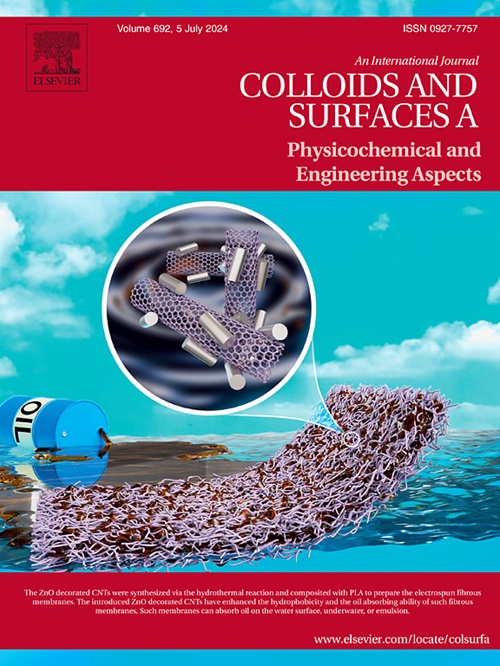Microwave-assisted synthesis Co-doped Fe3P/N-doped carbon with highly modulated electron structure and excellent electrocatalytic activity for acidic water splitting
IF 4.9
2区 化学
Q2 CHEMISTRY, PHYSICAL
Colloids and Surfaces A: Physicochemical and Engineering Aspects
Pub Date : 2025-05-02
DOI:10.1016/j.colsurfa.2025.137111
引用次数: 0
Abstract
With the increasing global interest in renewable energy, hydrogen production through water electrolysis has emerged as a promising method for clean energy generation. However, the efficiency of water splitting, particularly in acidic conditions, is limited by the need for high-performance electrocatalysts for the hydrogen evolution reaction (HER) and oxygen evolution reaction (OER). In this work, Co-doped Fe3P/N-doped carbon composites have been prepared fast by microwave assistance with enhanced electrocatalytic activity and stability in 0.5 M H2SO4. The doping of Co facilitated the transfer of electrons from Fe to Co, modified the electronic structure of metal active sites, thereby enhancing catalyst performance. The optimized Co0.2Fe0.8Px@NC catalyst exhibited superior HER and OER activity, with low overpotentials (91 and 251 mV for HER and OER, respectively) and Tafel slopes (60.3 and 55.3 mV/dec for HER and OER, respectively), and demonstrated excellent stability. In addition, the catalyst showed competitive performance in a two-electrode system for overall water splitting, achieving a high current density at low voltage. The novelty of this research lies in the integration of metal phosphides and nitrogen-doped carbon, providing an efficient and cost-effective approach to bifunctional electrocatalysts for water splitting applications with high performance and durability.
微波辅助合成具有高调制电子结构和优异电催化活性的Fe3P/ n掺杂碳
随着全球对可再生能源的兴趣日益浓厚,水电解制氢已成为一种有前途的清洁能源生产方法。然而,水分解的效率,特别是在酸性条件下,受到析氢反应(HER)和析氧反应(OER)需要高性能电催化剂的限制。本文利用微波辅助快速制备了Fe3P/ n掺杂碳复合材料,并在0.5 M H2SO4中提高了电催化活性和稳定性。Co的掺杂促进了电子从Fe向Co的转移,修饰了金属活性位点的电子结构,从而提高了催化剂的性能。优化后的Co0.2Fe0.8Px@NC催化剂具有较好的HER和OER活性,过电位较低(HER和OER分别为91和251 mV), Tafel斜率较低(HER和OER分别为60.3和55.3 mV/dec),稳定性较好。此外,该催化剂在双电极系统中表现出具有竞争力的整体水分解性能,在低电压下实现了高电流密度。本研究的新颖之处在于将金属磷化物与氮掺杂碳相结合,提供了一种高效、经济的双功能电催化剂,用于高性能、耐用的水分解应用。
本文章由计算机程序翻译,如有差异,请以英文原文为准。
求助全文
约1分钟内获得全文
求助全文
来源期刊
CiteScore
8.70
自引率
9.60%
发文量
2421
审稿时长
56 days
期刊介绍:
Colloids and Surfaces A: Physicochemical and Engineering Aspects is an international journal devoted to the science underlying applications of colloids and interfacial phenomena.
The journal aims at publishing high quality research papers featuring new materials or new insights into the role of colloid and interface science in (for example) food, energy, minerals processing, pharmaceuticals or the environment.

 求助内容:
求助内容: 应助结果提醒方式:
应助结果提醒方式:


